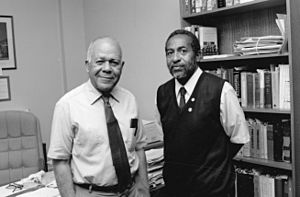Henry Cecil McBay facts for kids
Quick facts for kids
Henry C. McBay
|
|
|---|---|

McBay, left, and physicist Ronald E. Mickens
|
|
| Born | May 29th 1914 |
| Alma mater | Wiley College, University of Chicago |
| Scientific career | |
| Institutions | University of Atlanta, Morehouse College, Spelman College |
| Thesis | “Reactions of Atoms and Free Radicals in Solution" |
| Doctoral advisor | Morris S. Kharasch |
Henry Ransom Cecil McBay (born May 29, 1914 – died 1995) was an amazing American chemist and teacher. He was known for helping many students, especially those who faced challenges. McBay won many awards for his teaching and for guiding young people. He even helped start a group called the National Organization for the Professional Advancement of Black Chemists and Chemical Engineers (NOBCChE). This group helps Black chemists and chemical engineers succeed.
Contents
Early Life and Family
Henry Ransom McBay was born in Mexia, Texas, on May 29, 1914. In 1954, McBay married Shirley Ann Mathis. Shirley was a mathematician. She strongly believed in helping more minority students and researchers get into college and science careers.
Education and Chemistry Career
McBay went to Wiley College in Marshall, Texas. He paid for his studies with scholarships and by working jobs. He earned his first degree in 1934. After getting his master's degree in 1936 from Atlanta University, McBay went back to Wiley College. He wanted to help his younger brother and sister pay for their college education.
In 1940, McBay joined a new research team at Tuskegee Institute in Alabama. Their job was to find a good replacement for jute fiber. Jute was used for rope and sacks. Shipments of jute from India had stopped because of World War II. The Tuskegee team hoped that okra stems could be a good substitute. But McBay discovered that by the time an okra plant was fully grown, its stems were too brittle. Okra could be grown for food or for fiber, but not for both at the same time.
In 1942, McBay became a teaching assistant at the University of Chicago. He continued his studies there to earn his doctorate degree. This also helped him avoid serving in the U.S. military during the war. In 1944, McBay chose Professor Morris S. Kharasch as his research guide. He learned special ways to create and handle very explosive compounds. These compounds were valuable as building blocks for other chemicals.
His main research was about making new compounds from acetyl peroxide. In 1945, he earned his doctoral degree from the University of Chicago. His research later helped in developing a treatment for prostate cancer.
After his studies, McBay returned to Atlanta. He became an assistant professor at Morehouse College. In 1956, he became the head of the chemistry department. In 1982, McBay was named the Fuller E. Callaway Professor of Chemistry at Atlanta University. McBay taught for 41 years in the Atlanta University system. This included Morehouse, Spelman, and Atlanta. In 1990, McBay was the first Martin Luther King Jr. visiting scholar at the Massachusetts Institute of Technology. He continued to teach part-time until he passed away in 1995.
A Passion for Teaching
One of McBay's biggest goals was to share his love for chemistry with his students. He often showed how two different materials could combine to make something totally new. For example, he would mix a poisonous metal, sodium, with a poisonous gas, chlorine. The result was table salt! He wanted his students to be amazed by these processes, which he saw as small miracles. He guided many students from historically black colleges and universities. Many of them went on to earn their own doctoral degrees.
In 1951, he created a chemistry education program in Liberia. He did this for the United Nations Education, Scientific, and Cultural Organization (UNESCO).
Awards and Recognitions
Henry C. McBay received many honors and awards throughout his life:
- Norton Prize (for Excellence in Research in Chemistry) at University of Chicago, in 1944 and 1945.
- The "E.A.Jones (Edward A. Jones)/H.C.McBay/E.B.Williams Award (for Excellence in Teaching)" was created at Morehouse College, in 1973.
- Named Outstanding Teacher by the National Association for Black Chemists and Chemical Engineers, in 1976.
- The Herty Award (for Outstanding Contributions to Chemistry) from the American Chemical Society of Georgia, in 1976.
- The Norris Award (for Outstanding Achievement in the Teaching of Chemistry) from the American Chemical Society of the Northeast, in 1978.
- The Kimuel Huggins Award (for Outstanding Contributions of Chemistry, Human Endeavors) from Bishop College, in 1980.
- Received the E. A.Jones (Edward A. Jones)/H.C.McBay/E.B. Williams Award (for Excellence in Teaching) from Morehouse College, in 1981.
- The "Henry McBay Endowed Chemistry Scholarship" for students was started at Morehouse College, in 1986.
- Received an Honorary Doctor of Science degree from Atlanta University, in 1987.
- The "Nabrit-Mapp-McBay" Science Building was dedicated at Morehouse College, in 1989.
- Appointed as a Martin Luther King, Jr. Visiting Scholar at the Massachusetts Institute of Technology, from 1990-1991.
- Received the American Scholar Award from Delta Chapter of Georgia of Phi Beta Kappa, in 1991.
- Named a "Superstar of Science" by EBONY magazine, in 1991.
- Received an Honorary Doctor of Science degree from Atlanta's Emory University, in 1992.
- Received an Honorary Doctor of Science degree from Bowie State University, in 1993.
- Won the American Chemical Society Award (for Encouraging Disadvantaged Students into Careers in the Chemical Sciences), in 1995.
- The "Henry C. McBay Research Fellowships" for faculty members were started by the United Negro College Fund, in 1995.
- The "Henry C.R. McBay Chair in Space Sciences" was created (after his death) by Morehouse College and Clark Atlanta University, in 1996.
- Received an Honorary Doctor of Science degree (after his death) from Morehouse College, in 1996.

